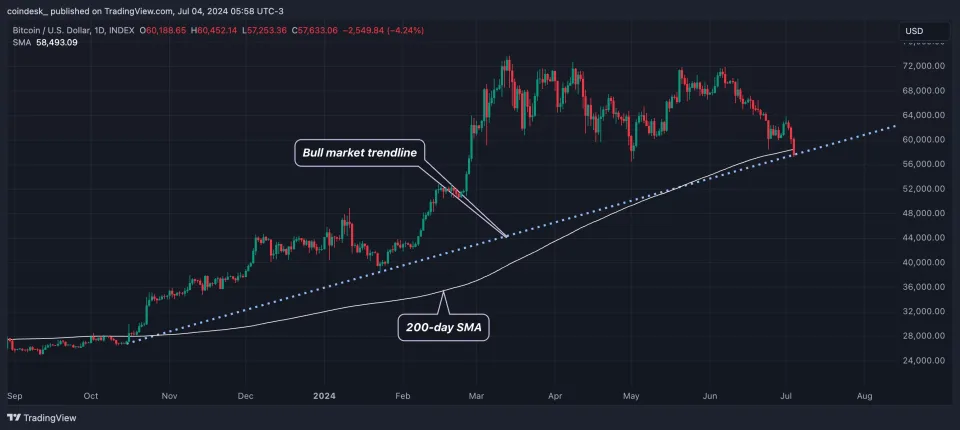
Bitcoin’s (BTC) struggle to maintain its value gathered momentum on Thursday as it fell for the third consecutive day, slipping below the pivotal 200-day simple moving average (SMA), a crucial barometer for long-term price trends in both traditional and crypto markets.
Market Analysis

Bitcoin’s descent past the 200-day SMA at $58,492 during European trading hours marks a significant shift in market sentiment. This drop to $57,300, a level not seen since May 2, indicates heightened bearish momentum. Historically, trading below the 200-day average suggests a downtrend, contrasting with the bullish sentiment that saw BTC soar past this mark in October, driven by the anticipation of a U.S. spot bitcoin ETF. This earlier optimism pushed Bitcoin to record highs above $70,000 by March.
Macro Factors
The cryptocurrency’s recent downturn is closely tied to broader economic trends, particularly the U.S. interest rate environment. Lower interest rates typically enhance the appeal of riskier assets like cryptocurrencies. However, minutes from the Federal Reserve’s latest meeting revealed a cautious stance. Policymakers, led by Chairman Jerome Powell, indicated they would hold off on rate cuts until there’s more definitive evidence that inflation is moving towards their 2% target. This conservative approach has dampened investor enthusiasm for Bitcoin.
Adding to the uncertainty is the upcoming release of the Labor Department’s non-farm payrolls report for June. Analysts forecast a slowdown in payroll growth to 195,000 from the previous month’s 272,000. The jobless rate is expected to remain at 4.0%, with average hourly earnings growth predicted to decelerate to 3.9% year-on-year from 4.1%. These figures, if they meet expectations, could further influence market sentiment and Bitcoin’s price trajectory.
Expert Insights
Valentin Fournier, a digital assets analyst at advisory firm brn, sees the recent decline as a potential buying opportunity. “We believe hawkish comments from Jerome Powell and the ongoing selling pressure are likely to push BTC down to $52,000,” Fournier stated in an email. “However, we recommend viewing this as a buying opportunity, as improving regulations around cryptocurrencies and cooling inflation in the U.S. have not been fully priced in and are likely to bring strong momentum once investors shift focus to a longer-term vision.”
Alex Kuptsikevich, a senior market analyst at FxPro, concurs with the bearish outlook, projecting prices could drop to $51,500 in the short term. “From the current position, a 12% drop to $51.5k (February consolidation area) is more likely than the same amount of growth to $65.8k (50-day MA),” Kuptsikevich noted in an email.
Technical Outlook
The recent breach of the 200-day SMA has drawn attention to the bull market trendline support at $57,590. This trendline, which connects the October and January lows, is crucial for maintaining bullish momentum. A close below this level (midnight UTC) could trigger additional selling, as traders often view trendline breakdowns as signals to offload assets.
Bitcoin’s slip below the 200-day SMA underscores the fragility of the current market sentiment, heavily influenced by macroeconomic factors and regulatory uncertainties. While some analysts view this as a temporary setback and a strategic buying opportunity, the market remains volatile. Investors will be closely monitoring upcoming economic data and Federal Reserve communications for further guidance on Bitcoin’s future direction.








